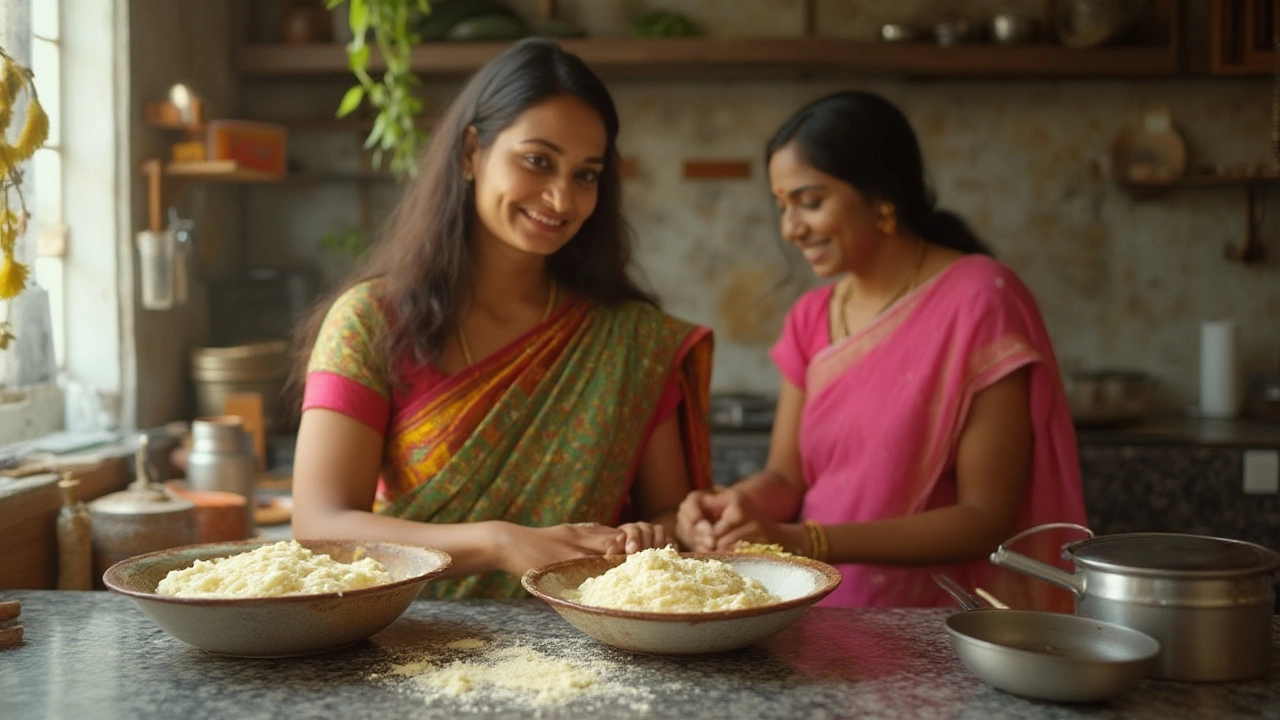There’s nothing quite like the anticipation as that first ladle of dosa batter hits a hot tawa—the gentle sizzle, the spreading steam, and the hope for a golden, paper-thin dosa with delicate, lace-like holes. But then, sometimes, that excitement fizzles out. Your dosa clings to the pan, seems dull, stays heavy, or, worst of all, just isn’t fluffy. If you’ve spent hours soaking, grinding, and waiting for good fermentation, only to end up with pancakes instead of proper dosas, you’re far from alone. The secret to light, crisp dosas actually starts days earlier and isn’t as mysterious as it seems. Still, a few small missteps can sabotage the whole process.
Understanding the Science of Fluffy Dosa Batter
Fluffiness isn’t just about a soft texture—it’s proof that the batter’s been fermented just right. The quest for the perfect dosa batter is a blend of tradition, microbiology, and kitchen intuition. At its core, dosa batter is a simple mix: rice, urad dal (split black gram), water, and salt. Yet, this simplicity hides some real science. When you soak the rice and dal, you prepare them to transform. Grinding them helps release natural sugars and exposes their starches. Now, when you let this batter sit, wild lactobacillus bacteria (think good bacteria from the air and ingredients) feast on these sugars, producing carbon dioxide as a byproduct. This gas forms all those precious air pockets that make the dosa light and bubbly.
City dwellers, listen up: tap water loaded with chlorine can slow fermentation. High-end dish soaps, scrupulously clean utensils, and cold rooms, especially during rainy or winter months, can turn your dreams of fluffy batter into a struggle. Most South Indians have stories about grandmothers who could tell if a batter would rise just by touching it, but for the rest of us, those cues aren’t always obvious. Here’s where temperature, lasting between 28°C and 32°C (about 82°F to 90°F), actually matters; that’s what triggers the wild yeasts and lactic acid bacteria to go to work. Anything much colder and you’ll be waiting—and waiting. Anything warmer, and your batter risks turning sour.
| Ideal Fermenting Conditions | Recommended Range |
|---|---|
| Soaking Time | 4–6 hours |
| Grinding Water Temperature | Room temperature or slightly warm (not hot) |
| Fermentation Time (Summer) | 8–10 hours |
| Fermentation Time (Winter) | 12–16 hours |
| Ambient Room Temperature | 28–32°C (82–90°F) |
Grinding technique isn’t trivial either. Wet grinders—those massive stone contraptions—mimic the friction and heat needed for extraordinary batters. Mixies (blenders) often overheat the batter, killing some of those good bacteria, and end up making the batter slightly dense. A key tip: always grind urad dal first until fluffy and then add rice. While grinding, sprinkle water slowly. Batter that’s too runny makes thin, lifeless dosas, but batter that’s too thick slows fermentation and stays gummy inside.
Common Mistakes That Sabotage Fluffiness
Here’s a hard truth: tiny errors at any stage, from soaking to storage, can mean the difference between fluffy and flat. First, using old or poor-quality urad dal ruins the magic. Fresh, split, and husked urad dal has more power to ferment. If your dal is pale or smells off, don’t use it. Second, wrong rice ratio: dosa batter isn’t just rice. The classic ration is about three parts rice to one part urad dal (by volume), though some swear by two-to-one or even four-to-one. Too much rice, and your batter will lack elasticity; too little, and the dosa turns out dense.
Let’s talk salt. Some cooks add it before fermentation, some after. If your kitchen is warm, salt before fermentation keeps wild yeasts in check, preventing your batter from turning too sour. In colder climates, wait until fermentation finishes before adding salt; salt can slow down the crucial bacteria needed to achieve that fluffy rise. And about water: always opt for filtered or boiled-and-cooled water, especially if your tap water is chlorinated. Chlorine kills bacteria—including the good guys needed for that rise.
Your container matters, too. Fermentation produces carbon dioxide, which expands and needs room. If your container is packed to the brim, your batter will spill or struggle to rise. Leave at least 25% headspace, and lightly place a lid—never an airtight seal—so gasses can escape.
What about the weather? In cool climates, fermentation slows way down. People often set their batter in a switched-off oven (with the oven light on) or wrap it in a blanket. But don’t overdo it; too much warmth or keeping it near a running oven can over-ferment and make the batter too sour and thin. Some even pop a small bowl of hot water next to their batter to warm things up gently—simple, but surprisingly effective.
- Never use a stainless steel container. Go for glass, ceramic, or food-grade plastic, which retain just enough warmth for fermentation.
- Don’t over-grind or under-grind: grainy batter won’t ferment uniformly, and ultra-smooth batter can sometimes fail to trap air.
- Avoid covering the batter with an airtight lid. Keep it loose so wild yeasts get in, and carbon dioxide gets out.
- Never add ice water to grind—the cold slows fermentation and invites failure.
- Check your batter after 8–10 hours in a warm kitchen, or up to 16 hours if it's chilly. It should look puffy, with tiny bubbles; when you gently stir, you should feel it’s lighter.

Troubleshooting: Why Your Batter Isn’t Fluffy (And How to Fix It)
So, the next morning, you peek under the lid. If your batter’s just... sitting there, heavy and unrisen, don’t despair. Rescue missions are still possible. First, check the temperature. If there’s any chill, move the container to a warmer spot or wrap it in a thick cloth. Some kitchens stash their batter next to a rice cooker or inside the oven with the light on—it really does make a difference.
Dosa batter can stall if your dal was old or over-processed. If so, try adding a spoonful of soaked and ground fenugreek seeds next time. Fenugreek not only lends a gentle aroma but also encourages a better rise thanks to its natural mucilage. This tip is especially a game-changer during winter when fermentation slows dramatically.
Batter over-fermented? If your kitchen is too warm, you may end up with an overly sour, thin, and bubbly mixture. Don't just toss it. Dilute slightly, ladle onto the tawa, and try making thick uttapams or soft set dosas instead. For the next try, shorten your fermentation window or ferment at a slightly cooler spot—moving up a shelf or two can lower the temperature by a crucial couple of degrees.
If your batter is thin and limp, blend in a couple of tablespoons of rice flour, let it sit for 30 minutes, and see if that helps rescue structure for the next batch. And if batter after batter keeps falling flat, invest in fresh dal and rice from a trusted store. Freshness is more than a buzzword—older grains just have fewer living enzymes and weaker fermentation capacity.
Sometimes, the secret is a bit of improvisation. For a quick fix when fermentation just isn’t happening, mix in half a teaspoon of instant yeast with a pinch of sugar into the batter and keep it somewhere warm. You won’t get quite the same tang as natural fermentation, but you’ll get bubbles in a couple of hours for a decent emergency dosa night.
- Don’t stir fermented batter vigorously. Gently fold so you don’t pop all those precious bubbles.
- If the top layer looks dry or forms a thin crust, drizzle a splash of water before stirring and see if you get a lift.
- Always clean your grinder, blender jar, ladles, and fermenting container with warm water only—dish soap residue can mess with fermentation.
Secret Pro Tips and Unusual Tricks for Perfect Dosa Batter
Even if you’ve got the basics down—a well-fermented, fluffy batter—it’s really the little tweaks that separate good home dosa from mind-blowing, restaurant-level perfection. Adding a handful of cooked rice or leftover rice while grinding urad dal does wonders for fluffiness; it helps the batter retain water and gives you those jaw-dropping bubbles. Some add a spoon or two of poha (beaten rice) while soaking the rice—it softens the batter just enough, especially if you’re using short-grain rice.
If humidity is an issue (especially in coastal cities or during monsoon), keep the batter covered with a dry kitchen towel so condensation doesn’t drip back in and thin out the batter. In dry weather, a damp cloth placed over the lid keeps the top layer from crusting up. For super-close results to South Indian breakfast joints, try sourcing idli rice rather than regular parboiled or long-grain rice. Idli rice soaks up more water, ferments evenly, and gives a classic, pillowy texture.
Home tawa matters, too: a well-seasoned, thick, cast-iron pan locks in heat and forms those signature brown webs. Never use a nonstick pan, as it won’t give the beautifully crisp texture authentic to dosa. Always heat the tawa until water sizzles and skitters across its surface before pouring; then, quickly reduce the heat just before spreading batter, so the tiny bubbles in your well-fermented batter have a chance to expand into airy holes without burning.
Finally, use your senses as guides. Don’t just watch a clock—smell the batter (it should be mildly tangy, never sharply sour), feel it (airy but not foamy), and trust your eyes (look for visible bubbles and a gentle lift). When you master these subtleties, each batch turns into a satisfying ritual instead of a nerve-racking experiment.
- For festive brunches or showing off, add a ladle of coconut milk to the batter for an extra-rich aroma.
- Mix in a pinch of sugar just before fermenting to feed the wild yeast (especially handy in dry climates).
- Always prepare dosa batter a day in advance. If your batch turns perfect, save some as a "starter" for your next round. This practice, as old as dosa itself, builds better flavor and consistency over time.
No need to fear flat dosa mornings anymore. Perfecting the art of fluffy dosa batter is part alchemy, part patience, and a whole lot of practice. Once you’ve nailed it, trust me, it feels like kitchen magic—every single time.
